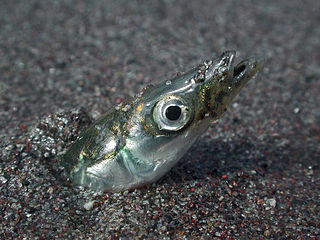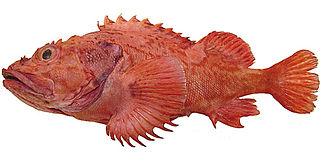
Sand eel or sandeel is the common name used for a considerable number of species of fish. While they are not true eels, they are eel-like in their appearance and can grow up to 30 cm (12 in) in length. Many species are found off the western coasts of Europe from Spain to Scotland, and in the Mediterranean and Baltic Seas.

Moray eels, or Muraenidae, are a family of eels whose members are found worldwide. There are approximately 200 species in 15 genera which are almost exclusively marine, but several species are regularly seen in brackish water, and a few are found in fresh water.

Ophichthidae is a family of fish in the order Anguilliformes, commonly known as the snake eels. The term "Ophichthidae" comes from Greek ophis ("serpent") and ichthys ("fish"). Snake eels are also burrowing eels. They are named for their physical appearance, as they have long, cylindrical, snake-like bodies. This family is found worldwide in tropical to warm temperate waters. They inhabit a wide range of habitats, from coastal shallows and even rivers, to depths below 800 m (2,600 ft). Most species are bottom dwellers, hiding in mud or sand to capture their prey of crustaceans and small fish, but some are pelagic.

A sand lance or sandlance is a fish belonging to the family Ammodytidae. Several species of sand lances are commonly known as "sand eels", though they are not related to true eels. Another variant name is launce, and all names of the fish are references to its slender body and pointed snout. The family name means "sand burrower", which describes the sand lance's habit of burrowing into sand to avoid tidal currents.

Vipera ammodytes is a viper species found in southern Europe, mainly northern Italy, the Balkans, and parts of Asia Minor. Like all other vipers, it is venomous. It is reputed to be the most dangerous of the European vipers due to its large size, long fangs and high venom toxicity. The specific name, ammodytes, is derived from the Greek words ammos, meaning "sand", and dutes, meaning "burrower" or "diver", despite its preference for rocky habitats. Five subspecies are currently recognized, including the nominate subspecies described here.

The lesser sand eel or sand lance is a species of fish in the sand lance family Ammodytidae. It is an elongated cylindrical fish which may be up to 20 centimetres (7.9 in) long.

Heteroconger is a genus of marine congrid eels. These small, slender garden eels live in groups where each individual has its own burrow. Usually, only the head and front half of the body is visible. The greatest species richness is in the Indo-Pacific, but species are also found in the warmer parts of the Atlantic and the eastern Pacific. Its name relates to how a huge colony of the eels looks swaying in the current.

Raitt's sand eel, also known as the lesser sand eel, is a small semi-pelagic ray-finned fish found in the North Atlantic Ocean. The Raitt's sand eel is member of the family Ammodytidae which includes all 31 species of sand eels, often referred to as sand lances. Contrary to their name sand eels, including Raitt's sand eel, are not true eels and instead belong to the order of “weever-like” fishes, the Trachiniformes.

Eels are ray-finned fish belonging to the order Anguilliformes, which consists of eight suborders, 20 families, 164 genera, and about 1000 species. Eels undergo considerable development from the early larval stage to the eventual adult stage and are usually predators.

Careproctus is a genus of snailfishes found in benthic and benthopelagic habitats in the Atlantic, Pacific, Arctic and Southern Oceans. Whether they truly are absent from the Indian Ocean is unknown and might be an artifact of limited sampling. They range from shallow coastal seas in the far north of their range to the abyssal zone, at depths of 6 to 5,459 m (20–17,910 ft). In the Northern Hemisphere they mostly live shallower than Paraliparis, but this pattern is reversed in the Southern Hemisphere. Although almost entirely restricted to very cold waters, a single species, C. hyaleius, lives at hydrothermal vents.

Scolecenchelys is a genus of eels in the snake eel family Ophichthidae.
Yirrkala is a genus of eels in the snake eel family Ophichthidae. It is named after Yirrkala, an indigenous community in Arnhem Land, in the Northern Territory of Australia.
Allocareproctus is a genus of marine ray-finned fishes belonging to the family Liparidae, the snailfishes. These fish are found in the northern Pacific Ocean.

Adelosebastes is a monotypic genus of marine ray-finned fish belonging to the subfamily Sebastinae, the rockfishes, part of the family Scorpaenidae. The only species in this genus is Adelosebastes latens, the Aleutian scorpionfish. It is found in the northern Pacific Ocean.
The angry worm eel is an eel in the family Ophichthidae. It was described by Peter Henry John Castle and John E. McCosker in 1999. It is a tropical, marine eel which is known from the eastern Indian and western central Pacific Ocean, including India, Indonesia, the Straits of Malacca, northern Australia, and the Philippines. It is known to inhabit shallow, turbid estuaries, and to a lesser extent the deeper water over soft substrates. Males can reach a maximum total length of 29.6 centimetres.
The Pacific spoon-nose eel is an eel in the family Ophichthidae. It was described by José Luis Castro-Aguirre and Sergio Suárez de los Cobos in 1983, originally under the genus Notophtophis. It is a marine, tropical eel which is known from the eastern central and southeastern Pacific Ocean, including the Gulf of California, Colombia, Mexico, Costa Rica, Nicaragua, Ecuador and Panama. It dwells at a maximum depth of 10 metres (33 ft), and inhabits sand and mud sediments. Males can reach a maximum total length of 140 centimetres (55 in), but more commonly reach a TL of 60 centimetres (24 in).
Ammodytes americanus, also known as American sand lance, American sand eel, and sand launce, is a small fish in the family Ammodytidae. First described by James Ellsworth De Kay in 1842, it is widespread in the western North Atlantic. Like all sand lances, it has a long, thin body with a pointed snout; mature fish typically range from 4 to 6 in in length, though some may reach 7 in (18 cm). Its back is greenish-brown, while its sides and abdomen are silvery. It has a long, low dorsal fin which extends along most of its back, folding into a groove at the fin's base when not in use. Its anal fin is roughly the same height as the dorsal fin, and extends over the posterior third of the fish's body. Its pectoral fins are small, and its caudal fin is forked. Its mouth is large and toothless, with a lower jaw that extends well beyond the upper. It typically travels in large schools, spending most of its time relatively near the water surface. It feeds primarily on plankton, though it is known to take small clams and snails from the sea floor, presumably when plankton is scarce. Towards dusk, schools of A. americanus bury themselves in sand, typically from 1 to 6 in below the sand's surface close to the water's edge; they avoid rocky areas. They do this to avoid being detected by night-hunting species such as bluefish and stripers.

The Turbot Bank is a shelf bank and mound feature of the seabed of the North Sea that lies off the east coast of Scotland, about 44 kilometres (27 mi) east of Peterhead. The depth of water above the bank varies from 60 m below sea level on top of the bank down to 80 m at its margins. It has been designated as a Nature Conservation Marine Protected Area since 2014.
The smooth sandeel is a species of sand eel in the family Ammodytidae.














